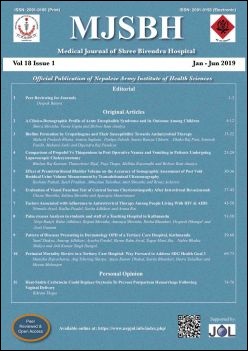Palm Creases Analysis in Students and Staff of a Teaching Hospital in Kathmandu
Keywords:
crease, palm, Simian, SydneyAbstract
Introduction: Palm creases have been studied for a long time and have been recently found to be helpful in tracking underlying medical and genetic conditions. Scientific study and typing of palm prints have been found to be lacking in the Nepalese population
Methods: A cross sectional study was done on 252 subjects, 153 male and 99 females, from Kathmandu, Nepal. Subjects were selected by purposive sampling from different age groups. Demographic profile including age, sex, and handedness was collected. Palm print pattern was recorded by digital photography. Each photograph was analysed visually by single observer and pattern of palm crease was noted. Variation of each crease was also noted.
Results: On the basis of relation between radial longitudinal crease and proximal transverse crease, 17.3% subjects had open type of palm crease which was significantly more in females while 76.6% subjects had closed type crease which was significantly more in males. Meeting type of palm crease was found in 5.7% of subjects. On the basis of relation between proximal and distal transverse crease, normal crease type was found in 90.1% of subjects, Simian type was found in 7.7% subjects and Sydney type was found in 1.4% of subjects. The concordance of this pattern in left and right palms was found statistically significant.
Conclusions: This study presented data from 252 seemingly normal healthy subjects and found that most of them had the normal with no branching, that is normal 1 and closed crease types. Most of the individual major creases were seen to be branched type.
Downloads
Downloads
Published
How to Cite
Issue
Section
License
This license enables reusers to distribute, remix, adapt, and build upon the material in any medium or format for noncommercial purposes only, and only so long as attribution is given to the creator.




